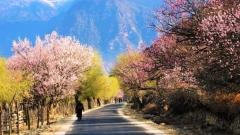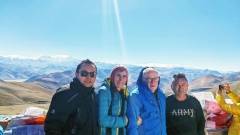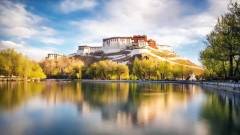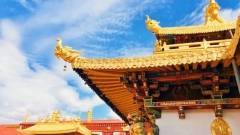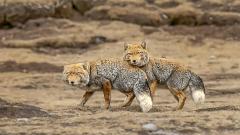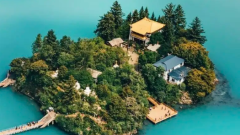Pangong Lake – locally known as Pangong Tso – is one of the Himalayan region’s most iconic high-altitude lakes. Perched at roughly 4,200–4,350 meters above sea level, the lake stretches for well over 100 kilometers from its eastern basin in Tibet to its western reaches in the Indian-administered Ladakh region. Pangong’s most famous feature is its mood-changing water – shifts from deep indigo to turquoise, green and gray depending on sun angle, depth and suspended minerals – framed by barren ridgelines and, in places, snowcapped peaks.
Why Pangong Tso Is Unique
Geography and Hydrology
Pangong is a landlocked (endorheic) lake formed in a rift valley. Unlike many alpine lakes, it displays a curious variation in salinity: parts of the basin are more saline while others behave like freshwater pockets. The lake freezes in winter despite its brackish nature — a reminder how elevation and extreme cold trump salinity when temperatures drop far below freezing. This mix of alpine climate and salt content gives Pangong its unusual ecological profile.
Border and Territory
The Line of Actual Control (LAC) cuts through parts of the lake. Different maps and sources split the lake’s length in different ways, but many travel accounts say a large portion lies in Chinese-administered Tibet and a smaller — but still substantial — section is in Indian-administered Ladakh. Because of this, tourists are typically permitted to visit only certain shoreline villages and viewpoints; crossing from one nation’s administered sector to another is strictly controlled and not allowed for ordinary visitors.

Wildlife and Bird Island: A Surprise Kingdom of Birds
Pangong contains more than a dozen islands of varying size. One of the best known is commonly called “Bird Island” — a rocky, shrub-dotted islet where gulls and waterfowl gather in large numbers during the breeding season. Bar-headed geese, brown-headed gulls, ruddy shelduck (red-crested pochard), crested ducks and other high-altitude species are frequently sighted; on peak days the sky can be full of circling birds, a spectacular sight for photographers and nature lovers. Visitors should note that landings on nesting islands are normally prohibited to protect breeding colonies; boat trips (where offered) usually keep a respectful distance.
The lake’s aquatic environment supports cold-adapted fish species (including varieties of snow trout in some basins) and a host of aquatic plants and invertebrates that sustain the food web. While Pangong is not a dense wildlife hotspot like a lowland wetland, its isolation means species here are adapted to extreme altitude and seasonal scarcity — making any sighting feel special.
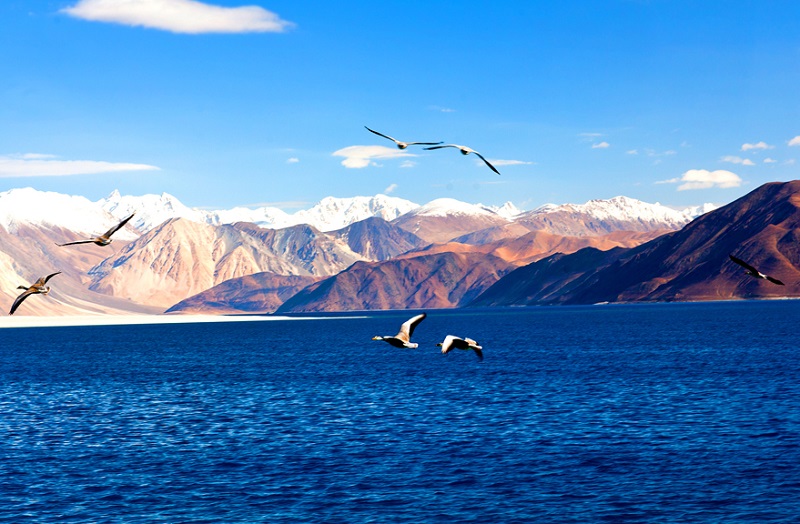
Best Time to Visit Pangong Tso
Seasonal Windows
The most practical and comfortable months to visit are late spring through early autumn — roughly May to September. During these months roads into high Himalayan passes are generally open, temperatures are milder (though still cold at night), and migratory birds come to nest on islands. Summer is when the lake looks its most spectacular: clear skies, vivid colors and accessible roads.
Weather Realities
Even in summer expect strong sun, dramatic diurnal temperature swings and thin air. Daytime highs can be pleasantly cool; nights frequently drop below freezing. Monsoon storms rarely reach the high plateau in full force, but local winds and sudden weather changes are common — always prepare for sun, wind and a rapid drop in temperature.
Permits, Restrictions & Border Safety
Paperwork You’ll Need
Because Pangong Tso lies in a sensitive border region, special permissions are required for visitors. Indian-entry tourists (visiting the Ladakh side) are usually required to obtain an Inner Line Permit (ILP) or Protected Area Permit (PAP) for restricted zones; foreign nationals often need a Protected Area Permit for travel to designated high-altitude lakes like Pangong. Rules change periodically and some permits are processed only via authorized travel operators, so confirm current requirements well in advance. (WanderOn)
Where You Can Go
Tourists are normally allowed to visit the public shorelines and villages such as Spangmik (on the Indian side) or the designated scenic stretches on the Tibetan side when travelling with a permitted tour. Cross-border travel that would take a visitor from one administered sector to another is not allowed, and military zones or observation points are off limits. Respect all signage and instructions from local officials — border areas are sensitive for security reasons.
How to Get to Pangong Lake
From Leh (Indian side)
Most visitors traveling to the Ladakh side start in Leh. The road from Leh crosses high passes such as Chang La and follows scenic but remote mountain valleys to Pangong. The drive is long (several hours from Leh) and involves altitudes above 4,000–5,000 m; many travelers stop overnight in Leh to acclimatize before attempting the drive.
From Ngari / Rutog (Tibetan side)
Access from Tibet (China) typically begins from towns in Ngari Prefecture (e.g., Rutog), and can be part of multi-day Tibetan itineraries. Distances are long and roads can be high and remote, so travelers often combine Pangong with other western Tibet highlights. Always arrange transport and permits in advance if approaching from this side.
Practical transport tips
- Book a reliable 4×4 or a tour operator with mountain driving experience.
- Acclimatize in Leh or a comparable town for 24–48 hours to reduce acute altitude sickness risk.
- Fuel, food and phone coverage are sparse; carry snacks, water, warm layers and power banks.
- Drive times are estimates — weather and roadwork can add significant delays.
What to Expect at the Lake: Sights & Activities
Colour Photography & Sunrise Views
Pangong’s color shifts are a photographer’s dream. Early morning and late afternoon light produce the richest contrasts — golden ridgelines set against turquoise shallows, or deep blue expanses under a high sun. Bring a polarizing filter if you shoot with a camera; it helps saturate the sky and reduce glare on water.
Birdwatching and Boat Trips
Boat tours (where available from permitted operators) will circle islands and give you a chance to observe nesting gulls and waterfowl from a respectful distance. Landing on bird islands is usually forbidden. Binoculars and a telephoto lens are recommended for close-up views without disturbance.
Camping & Stargazing
In summer, lakeside camping is popular — but make sure your campsite is inside approved areas and that you follow local rules. At night the high plateau yields breathtaking stargazing thanks to minimal light pollution: the Milky Way often feels low and expansive above the lake.
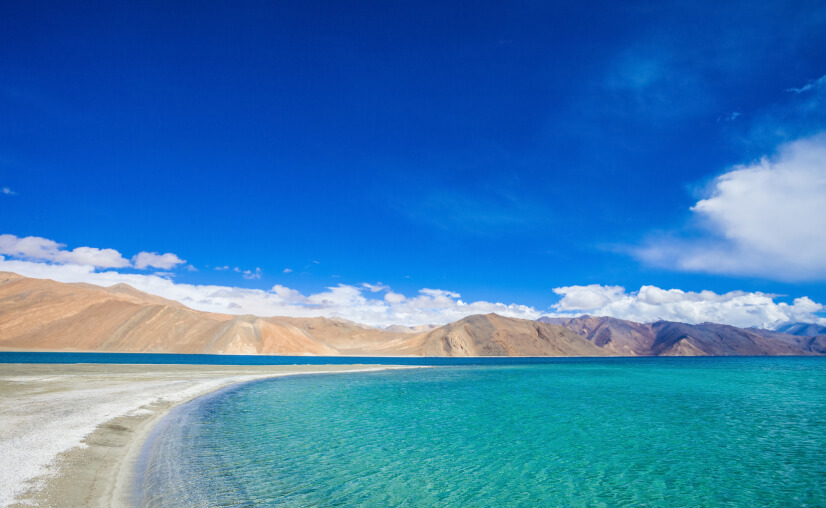
Practical Travel Tips & Safety
- Acclimatize first. Don’t rush from low elevation to 4,200+ m — give yourself 24–48 hours at intermediate altitude to reduce risks of altitude sickness.
- Pack layers. Windproof outer shells, warm mid-layers, a hat and gloves are essential even in summer.
- Stay hydrated and eat lightly. High altitudes dehydrate you faster; sip fluids and avoid heavy alcohol.
- Bring sunscreen and sunglasses. UV is strong at altitude; protect skin and eyes.
- Respect wildlife and nesting birds. Keep distance, don’t make loud noises near colonies, and never feed wild animals.
- Cash and communications. ATMs are sparse; carry cash for permits, food and small purchases. Phone coverage may be spotty — download maps for offline use.
- Leave no trace. Pack out all trash; fragile high-altitude ecosystems recover slowly.
Responsible Travel and Cultural Respect
Pangong sits in a fragile environment and in areas inhabited by local communities whose livelihoods and cultures are shaped by altitude and climate. Support local businesses where possible, ask permission before photographing people, and follow local guidance on camping and waste disposal. Respect the border and military signage; trespassing into restricted areas can have serious legal consequences.
Quick FAQ about Pangong Lake
Do foreigners need permits for Pangong?
Yes — foreign travelers usually require a Protected Area Permit (PAP) or related permit for restricted border areas; local operators often help arrange these documents. Confirm current requirements well before your trip.
Can I cross the lake into the other country?
No. The border and line of control are strictly enforced; ordinary tourists may not cross from one administered sector to another. Always follow official directions and the limits of your permit.
Is camping allowed?
Camping is allowed in many areas during the open season but only in approved locations. Use designated campsites and follow local camp rules.

Travel to Pangong Lake and Enjoy a Great Tour
If you prefer a guided and permit-assisted experience, China Dragon Travel specializes in Himalayan and Tibet region itineraries and can arrange the logistics, permits and experienced local guides you need to visit Pangong Lake safely and comfortably. Whether you want a day trip with an expert driver and naturalist guide or a multi-day photographic camp, a licensed operator will reduce paperwork and let you focus on the landscape.



